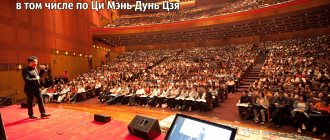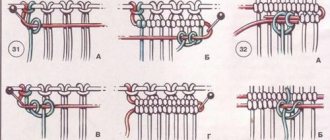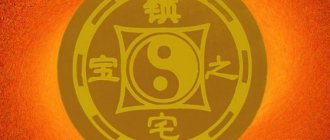Mantra (Sanskrit: मन्त्र) has three interpretations of literal translation:
- “an instrument for carrying out a mental act”;
- "liberation of the mind";
- “verse”, “spell”, “magic”;
It is a sacred text, word or syllable, the distinctive feature of which is the requirement for accurate sound reproduction.
For people who practice yoga, meditation, pranayama, this is a way of calming and relaxing through sound vibrations. There is an opinion that mantras help a person fulfill his desires, recover from illnesses, find love and various earthly blessings.
For every goal and desire there is a mantra:
Bija mantras.
Also known as “seed mantras”. They are a kind of prayers containing one or more sounds/syllables. As the masters say, bija mantras have greater power than all others, since they contain energy, the spiritual power of a particular Creator. It is for this reason that very often, in order to enhance the power of other mantras, syllables from the bija mantra are added to them;
Gayatri mantra. Written in Sanskrit, characterized by the poetic meter “gayatri”, consisting of 24 syllables. This is one of the most revered mantras, it is dedicated to Savitar (solar deity). According to mythology, Savitar made pilgrimages throughout the earth and through his bright light brought strength and longevity, and also drove out evil spirits. Legend has it that this deity transports the souls of the righteous with the help of his golden chariot;
Mahamrityumjaya mantra. It is believed that through repeated reading of this mantra, metabolic processes in the body are restored, the aging process is stopped and the human physical body is rejuvenated. Prescribed in difficult, sometimes even hopeless situations, it neutralizes the adverse effects of the planets, while healing, giving energy, self-confidence and spiritual strength;
Mantra Om. It is primary, it contributed to the creation of the entire universe. Helps to open one’s own energy channels, calm the mind and relax the body, clears the mind and thereby gives a person the opportunity to rise to the next stage of internal development;
Om Mani Padme Hum.
The sages believe that this mantra contains all eighty-four thousand teachings of the Buddha. It helps cleanse the body, speech and mind;
Om namah Shivaya.
Perhaps one of the most famous mantras in the whole world, it is considered universal, that is, it is used not only to fulfill a specific desire, but before any fateful event or for improvement in the daily practice of the spirit;
Panchabrahma mantra.
Consisting of six syllables, this mantra of the five faces of Shiva: Sadyojata (creation), Vamadeva (sustainment), Aghora (destruction), Tatpurusha (hidden mercy), Ishana (manifest mercy);
General concept of mantra
Mantra is a set of sounds in Sanskrit that have a spiritual effect.
Its literal translation from Sanskrit will help you understand the meaning of the word:
- man - mind, think, reasoning, reflection;
- tra(p) - liberation, purification, protection.
This is not the only interpretation.
The commentary to the book Hatha Yoga Pradipika states that “mantra” consists of the roots of the words meaning “repeat” and “freedom.”
Mantra is the practice of repeating syllables over and over again. Its essence is sound. Its vibration has a powerful energy that can influence human life - bring wealth, personal happiness, health, etc.
Operating principle
According to Hindu and Buddhist teachings, any form is a manifestation of sound. The world began with the vibration of Sabdabrahman. These vibrations split and manifested themselves in the form of 50 sounds (varnas), which became the basis of all physical forms. Gradually, the first varnas were forgotten, but on their basis Sanskrit arose, also known as the “language of the gods,” or Devavani.
Mantras improve blood circulation and tone the lungs.
Mantras are read in Sanskrit, thus, during practice, sounds are pronounced as close as possible to the original Absolute. Sound vibrations cause changes not only on the spiritual, but also on the physical level.
Vibration in the body while singing a prayer produces several effects simultaneously:
- improves blood circulation;
- tones the lungs;
- improves gas exchange;
- stimulates the endocrine system;
- massages internal organs, toning them;
- normalizes the nervous system.
When the number of spells is small (1-3), and the repetition is repeated many times, the body adapts and after a while it itself turns into a kind of vibrating energy.
Useful magical properties for humans
In the material world, a person often thinks and acts within the framework of generally accepted rules and prejudices; he is influenced by upbringing, habits, complexes, anxieties and fears. A mantra allows a person to:
- discover your higher self;
- expand the limits of worldview;
- understand your true aspirations, not imposed from outside;
- get rid of restrictions;
- see new opportunities;
- get protection from troubles;
- achieve serenity and happiness;
- get rid of bad habits.
Mantras allow a person to get rid of bad habits.
Chanting a prayer always has a purpose.
Pronounced sounds create vibration and cause various changes:
- AUM - clarifies consciousness;
- HUM - eliminates negative influences, damage;
- IM - protects from ill-wishers;
- KHRIM - promotes healing of body and soul;
- CHEN - makes life joyful;
- SHRIM - awakens creative abilities;
- DON - develops eloquence;
- SI - heals the soul, relieves anxiety and fear;
- GAM - ensures material well-being;
- RAM - gives patronage to high-ranking officials.
Differences from Spells
Although mantras are a means to gain higher knowledge and achieve what you want, they are not traditional spells or prayers.
The main thing in a spell is the meaning put into the words. The sound characteristics of a conspiracy or prayer have no meaning.
The main thing in a mantra is sound vibrations. The sounds themselves are filled with deep meaning. Therefore, the text of a Buddhist prayer should not be translated into another language. Mantras work even if a person does not know the meaning of the spoken word. Without correctly reproduced sounds, the mantra will have no power.
The meaning and meaning of mantras
It is difficult for the European mind to perceive the true meaning of the mantra, which for an Easterner is organically perceived and absorbed with mother’s milk. For us, the closest concepts are such phenomena as prayers, spells, psalms.
However, between them and the true mantra there still lies a bottomless abyss. In prayer appeals to God, the meaning, the internal message, is important, while mantras require not only the presence of a semantic component, but also 100% accuracy of pronunciation.
Mantra is the vibration of the Universe. It cannot be distorted or pronounced incorrectly, otherwise its entire sacred meaning will be lost, and this will only be an attempt at a fruitless shaking of air.
History of appearance
Sound energies have always existed. They were discovered thousands of years ago by ancient sages. During their meditations, they heard a repeating sound vibration. It could vary in power, sometimes being a manifestation of cosmic consciousness, and sometimes a correspondence to various natural phenomena.
The prophets wrote down mantras in the Vedas.
The prophets gave sounds the form of words and wrote them down in the Vedas. Over time, in Buddhism and Hinduism, mantras began to be called not only verses from this sacred book, but also other phrases that have an enlightening effect on the mind.
The attitude of other religions to mantras
Mantras are found in the schools of Buddhism, Hinduism, Sikhism and Jainism. In Japanese culture there is a branch of Buddhism (Shingon). In this teaching, prayer also involves speaking or singing words and sounds.
In Buddhist schools they study mantras addressed to the deity.
Varieties of mantra include chants, antiphons and hymns, which are present in Christianity, Taoism, and Zoroastrianism.
Main varieties and their characteristics
There are many mantras; for almost every human wish there is a set of sounds that fulfills it. According to their meaning and meaning, prayers are divided into several groups.
Saguna
Contains the name of God, who awakens under the influence of sound vibration.
Prayer has 6 features:
- She has a prophet. The rishi (sage), recognizing the voice of the deity during meditation, passed on the knowledge to his disciples.
- She has a patron deity.
- She has a special power - “bija”, i.e. “grain”, “seed”, “potency” - and contains information about the past and future. This force is the basis of any beginning, be it sound or thought.
- It has a poetic meter.
- Has dynamic strength.
- Has kilaku. This is like a cork that seals the pure consciousness hidden in the mantra. Frequent repetition creates energy that dislodges this wedge and allows one to achieve enlightenment and see divine visions.
Rishi passed on knowledge to his disciples.
It is important to pronounce Saguna spells carefully and accurately, because they contain the name of God. The slightest distortion of a verse changes its meaning; the text ceases to correspond to the deity and cannot awaken him.
Nirguna
They do not have divine personalization. Such mantras are practiced by people who do not worship any god or profess a religion. These abstract prayers help to achieve unity with the Higher Mind, with the energy of the Universe.
Their meaning is accurately conveyed by the literal translation of the famous Vedantic phrase “Tat Tvam Asi”: That (Brahman, deity) is You (reading the mantra).
Bija
The seed mantra is considered the basis of the foundations and has powerful creative energy. They are short phrases or syllables that have no semantic meaning. They affect human energy channels and centers.
Bija is considered the basis of the foundations.
Each chakra has its own bija:
- muladhara—LAM;
- svadhisthana - YOU;
- manipura - RAM;
- anahata—YAM;
- visuddha—NAM;
- ajna - OM;
- sahasrara - AUM.
Bija is often included in other mantras to enhance their effect.
Gayatri
A set of words of 24 syllables is dedicated to the Sun God - Savitar. He bestows health and longevity, expels evil spirits, and also transports human souls to another world.
This mantra works on 3 levels:
- earthly (Bhur);
- astral (Bhuvah);
- heavenly (Matchmaker).
Gayatri gives a person longevity.
Of all the mantras, Gayatri is considered the most powerful.
Ohm
The sound of the primal principle, containing the vibration of the creation of the Universe. Symbol of the triune deity (Trimuti).
The triad includes:
- Brahma (creator);
- Vishnu (preserver);
- Shiva (destroyer).
OM consists of 3 letters (A - U - M), symbolizing states of consciousness:
- wakefulness - A;
- drowsiness - U;
- dream - M.
Repeating the mantra of the universe allows a person to realize his destiny and achieve nirvana.
Hare Krishna
The 16-syllable “mahamantra” refers to the names of the god Krishna:
- Krishna (All-Attractive) and Rama (All-Pleasing) are the names of God in Sanskrit. These words can also be translated as “pleasure.”
- Hara is the highest energy of pleasure, helping to come into contact with God.
In the "mahamantra" there is an appeal to the god Krishna.
The great mantra is a person’s call to the energy of the Almighty, a bright and pure request for patronage and protection, an expression of love and devotion.
Panchabrahma
God Shiva, in order to create the Universe, manifested himself in the form of Panchabrahma. The creature had 5 faces (or mouths) symbolizing akasha, air, fire, water and earth. The whole world subsequently emerged from these elements.
Characteristics of 5 faces:
- Sadyojata (another name is Brahma, the creator) is the energy of creation. The face of "Born Today" is facing west.
- Vamadeva (Vishnu, the guardian) is the energy of maintenance, preservation. The face of the “Beautiful One” looks north.
- Tatpurusha (Maheshvara, concealer) - the energy of concealment, hidden grace. The "Supreme Soul" faces the east.
- Aghora (Rudra, destroyer) is the energy of destruction. The face of the “Non-Fearsome” is turned to the south.
- Ishana (Sadasiva, opener) - the energy of revelation, mercy shown. He is facing up.
In Panchakshara - Na-mah-Shi-va-ya - there is a syllable for each of the 5 faces.
Panchabrahma is the mantra of the five faces of Shiva.
Tips for Newbies
To achieve a good result, the text of the mantra must be pronounced accurately, for this:
- Choosing a suitable place where you can retire will infuse in the right way.
- Immediately before reading, meditate and visualize, imagining what you want.
- Select 1 suitable prayer.
- Keep your posture straight.
- The face should be facing east.
- Breathing is smooth and calm.
- Sounds must be pronounced in 1 key and drawn out.
- The reading number must be a multiple of 3.
- It is best to carry out this procedure at dawn, sunset or midday.
Classification according to origin
Mantras are:
- Vedic. They are based on sacred texts from the Vedas using the names of deities. Suitable for people who want to practice independently.
- Tantric. They are often read with the aim of obtaining something material, to solve practical life problems. The practice involves performing rituals related to blood, sex, wine, and meat.
- Puranic. Compiled by wise men. "Purana" is translated as "history". Sanskrit texts talk about the historical past, but the Bhavishya Purana also talks about the future.
Transfer of mantras from the teacher
There are a large number of mantras available on the Internet and in books. Many of them can be used for independent practice. However, most practitioners advise finding a teacher who will guide the beginner and help him avoid mistakes.
Practitioners advise finding a spiritual teacher.
In addition, there are a large number of prayers in Sanskrit that are not enough to simply read or hear.
Such texts are transmitted to the student directly from the original source (spiritual mentor). In this case, words become more powerful.
For example, the Medicine Buddha mantra is transmitted only from teacher to student:
“Tayata Om Behanzeya Behanzeya Maha Behanzeya Ranza Samutgate Soha.”
Features of use
For meditation (japa), it is useful to use beads (japa mala) - this will enhance concentration and not be distracted by counting how many times the prayer has been said.
It is useful to use rosary beads for meditation.
The mala, consisting of 108 beads, needs to be fingered only with the thumb and middle finger of the right hand. Having reached the Measure, which indicates that the 1st round of reading is over, you need, without crossing it, to turn the japa mala in the opposite direction. Some mantras are chanted for 16 circles, but depending on the experience of the practitioner or the availability of free time, it is allowed to chant spells for 1 circle.
The practitioner must follow a number of rules:
- Choose the right mantra. At first, it should have simple words and syllables to make it easier to reproduce sounds correctly. After some time, a person will find “his” prayer, which gives him the greatest relaxation and peace of mind. It is important to note that the selected phrases cannot be changed; they will need to be pronounced several meditations in a row.
- Before you begin, take a few deep breaths and exhales, then state the purpose of japa out loud.
- Say the prayer 108 times - the number of beads in the rosary. This is a sacred number: 1 means divine energy, 0 - perfection, 8 - infinity. You can repeat words any number of times, but not less than 3.
- Speak the text loudly, clearly and correctly.
- Repeat the mantra for at least 15 minutes.
It is important to meditate daily. Any time is suitable for practice, not only the recommended time from 4 to 6 am.
Myths about reading mantras
They can influence the human brain both consciously and subconsciously. There are several myths about reading them:
- You must pronounce them yourself. This is wrong. You can listen to recorded mantras, which will give a noticeable effect after a short period of time.
- It takes a long time to read (the longer the better). It's a delusion. It is enough to allocate 15 minutes a day for reading, but do it regularly. Only then can you notice the result.
- Already after 1 session you can feel the result. After 1 reading, the effect will not be as noticeable and lasting as after multiple sessions.
Pronunciation rules
Simply listening to mantras has no effect on a person. You can meditate to prayers just like any other sounds. Mantras must be pronounced (out loud or silently), only then do they show their power. When pronouncing the words of the spell, you need to achieve the feeling that the sound does not come outward, but is directed into the sky.
Signs of correct pronunciation:
- vibration in the abdomen and perineum;
- tickling sensation in the ears and throat;
- If you put your palm to your chest, you can feel that the vibration from the sound is stronger than when talking.
When the mantra is pronounced correctly, vibration occurs in the abdominal area.
The impact of a sacred text also depends on the manner in which it was spoken.
Whisper
A mantra read in a whisper affects a person’s energy field, the chakras. If the latter experience a lack or excess of energy, this has a bad effect on a person’s physical and mental health. Prayers, especially bija, restore energy balance and restore health.
In my mind
The most complex and effective practice. Affects the human psyche and soul. The ability to completely free your mind comes only after long training. A person mentally focuses on the internal sound of the mantra, while entering a state of trance.
The cause of many diseases and problems is wrong thinking. Casting spells in the mind cleanses the conscious and subconscious mind of destructive thoughts and stereotypes.
Loud
Loud pronunciation of the mantra affects the physical body. It is necessary to achieve tangible vibration in the body. Sounds must be pronounced while exhaling. You cannot take a breath in the middle of a sentence, because... this disrupts the rhythm, making the mantra ineffective.
Speaking loudly affects the body.
Loud chanting of the spell causes healing vibration in the body, deep breathing calms the nervous system.
Energy connections and chakras
There are energy nodes in the human body - chakras. They represent the intersection of channels through which energy circulates. The meaning of the word is translated from Sanskrit as wheel or circle. With their help, energy is generated, released and absorbed, and also transformed.
There are 7 chakras in the body:
- Muladhara
- Svadhisthana
- Manipura
- Anahata
- Vishuddha
- Ajna
- Sahasrara
Each of them has its own color and location on the body and performs its own functions. The energy of these chakras can be in 3 states:
- Normal . Then as much energy is produced as is necessary for normal human life.
- Excited . In this case, more energy is generated than required. This manifests itself in restlessness and anxiety.
- Oppressed . There is not enough energy for life.
Chakras are human energy centers
In the first case, the energy of each of them separately and all together is in a balanced state. Excited or depressed states indicate an imbalance of one, several or all chakras at the same time. In most cases, an imbalance of 1 chakra leads to disruption of energy circulation throughout the body.
In this case, balance needs to be restored, and reading mantras is one way to do this.
Examples of mantras for meditation
One or another prayer is chosen based on the current life situation.
Mantras are used to attract:
- Prosperity, wealth, money: “Om Shrim Mahalakshmiye Namaha.” A man greets the goddess of prosperity and generosity Lakshmi. You need to honor her without any selfish purpose, you need to maintain a sincere and pure state of mind, then the goddess will reward you with material well-being.
- Health: “Ra Ma Da Sa.” You need to meditate for about 30 minutes every day. Attention must be focused on the diseased organ. After a week, the person will feel that he is recovering.
- Love: “Om Mani Padme Hum.” You need to chant this mantra for at least 3 rounds of japa mala. The practitioner begins to radiate love himself and attract it to himself. It is also a prayer of forgiveness and enlightenment.
- Strength and energy: “Om Namah Shivaya.” If a person sincerely and lovingly bows before the god Shiva, he will not be left without a reward, because this god is generous and hears every request.
- Care and protection: “Om Tare Tuttare Ture Sokha.” People who are alone and confused turn to the mother of all Buddhas - Green Tara - in search of maternal love. The sympathetic goddess takes pity on them, warms them and protects them from harsh life.
How do mantras affect us?
Left completely alone, take a comfortable position and begin to play the sounds of the mantra. You will feel that your brain is gradually leaving all extraneous thoughts, it is concentrated only on the sound effect, the body is relaxed and filled with energy from the inside, and all worries and problems go away.
Our 21st century is fast-paced and tireless; in order to cope with it we have to constantly absorb a huge amount of information and try not to miss out on luck, take our place in the sun, and get ahead of others running to the finish line. This causes a person to experience stress, which ultimately leads to depression and mental and spiritual exhaustion. To relax, a civilized person resorts to alcohol and drugs, computer games and sitting for many hours watching TV.
But in this way it is impossible to rest and recover, and a mantra can give relaxation and rest not only to the body, but also to the mind and soul.
Effect and result of application
A person already has a model of the future projected in his consciousness. It is often formed on the basis of conventions, blocks, complexes, lack of self-confidence, etc. The mantra liberates and cleanses the mind from destructive influences. Under its influence, a person changes his attitude towards his dreams, thoughts, and himself.
The mantra clears the mind of destructive influences.
His worldview changes, he begins to make the right decisions. As a result, his life and future change.
Difficulties during classes
The first, and perhaps the most important obstacle to the implementation of any task is inertia, laziness and inaction, and, of course, lack of faith in one’s own strength.
Why do many people, having taken up some business with enthusiasm at the very beginning, very quickly cool down to it, without noticing any visible results during the period while they worked? This can arise either from a haphazard approach or from a lack of confidence in one's own potential.
If someone starts reading mantras every day, and after a month says that it does not bring any benefit, it only takes up time, he can stop and quit. He can continue, and then at the most unexpected moment he will receive the long-awaited result. Requests and wishes to the Divine Absolute, in whatever form it exists - in reality or in the minds of people, may not reach immediately. Sometimes the Higher powers seem to test the strength of the person asking or going.
In no case should you be led by your own momentary whims and your own laziness, but excessive zeal and zeal can also cause harm. Oddly enough, the effect of reading mantras in the vast majority of cases occurs when a person is very tired, he wants to rest, and has neither the strength nor the desire to continue.
Apparently, the Universe is patiently waiting for the moment when a person’s strength will be at its limit, and the mind will be entirely and completely focused on one task. It is then that the desired will merge with the actual. The main thing is to never stop reading mantric prayers every day, and not to stop there.
Approximately the same principle applies in sports, in career, and in many areas of human life and activity. Under no circumstances should you lose faith in yourself and in the successful completion of the task!
When they start to act
After the first 2 meditations, you may not notice any changes, because... the body and brain are still adapting to the new state.
What happens next depends on the goal:
- To calm your nerves or clear your mind before difficult work, 15 minutes of chanting a mantra will be enough.
- It will take about a month to notice the beneficial effects of prayer on your health.
- To change your destiny, you need at least six months of practice.
Spells begin to work from the very first meditation, but this is such an unobtrusive process that the degree of impact can be assessed only after some time.
Mantras in the modern world
When starting to comprehend the science of reading prayers, the practitioner must take into account several rules:
- Perform practices daily. Only in this case can good results be achieved.
- Do not read several sacred texts at once. It is better to start with one and move on to the other only after mastering the first.
You cannot achieve purification of the mind, achieve balance and spiritual development only with the help of mantras. To do this, it is important to monitor your thoughts and actions.
Mentors note that enlightenment can only be achieved through continuous development. To do this, they advise reading specialized literature, studying the life and culture of peoples, traveling more, and avoiding negative thoughts.
Safety precautions
Mantras should penetrate a person’s life gradually. If you overdo it, then either overwork and moral burnout will occur, or life will begin to change too quickly, chaotically, bringing trouble.
You need to work with mantras every day. First, 10-20 minutes, then increase this time to an hour. The body itself will tell you when you need to extend the practice - you will simply want to stay in a pleasant state of meditation a little longer.
It happens that the body does not keep up with the spiritual development of the soul. You will feel weak and apathetic. Physical activity will help maintain optimal balance. The more actively a person practices mantras, the more time he should devote to his body. In this case, it is enough to perform only feasible exercises - this could be sports, yoga, dancing or just regular walks.
Any sound has energy and power. Sometimes a person may feel the need to utter, for example, the word “happiness”, because as a result he feels uplifted and inspired. Such a deviation from the rules is permissible, but all the rules for pronouncing mantras apply to it.
Tips for the correct use of mantras
Before you start practicing, you need to understand how to use mantras correctly and how they work. There is no point in practicing them unconsciously, without understanding what can be achieved. In addition, it is worth considering that the mantras are read in Sanskrit, and this language is not very easy to pronounce for beginners.
Therefore, it is best to first contact an experienced teacher who will help you learn the mantras, tell you which ones are best suited in a given situation, and teach them how to read them correctly. You should not try to immediately learn the maximum number of different types of these sounds; it is better to focus on one and study it thoroughly, and then move on to the next. This is painstaking work that requires complete concentration and immersion in the process.
To understand which mantra to start with, you need to know yourself, decide what is most important in the current life situation, and what to focus on. For better concentration, beads are used - they help count the number of mantras spoken, and also have a calming effect and help you fall into a trance. It is better to choose a rosary that has 108 beads and another large one in order to understand when the prayer cycle has ended.
To begin with, you can visit places where prayers are read by specially trained people. Such sessions are regularly held in Buddhist temples and temples of other Hindu traditions. It will not be easy for a person inexperienced in this area to immediately get involved in the process, so it is worth first observing it from the outside, immersing yourself gradually.
If it is difficult to decide on the first mantra to study, then it is recommended to start with Om, as the most ancient and at the same time simple sound. It is pronounced while exhaling, on an empty stomach (like any other mantra), 2-3 hours after eating, with full awareness of the meaning of this sound. To pronounce it, you need to master a special breathing technique, which will allow you to establish the optimal balance of oxygen and carbon dioxide in the human body and tune it to the right wave.









